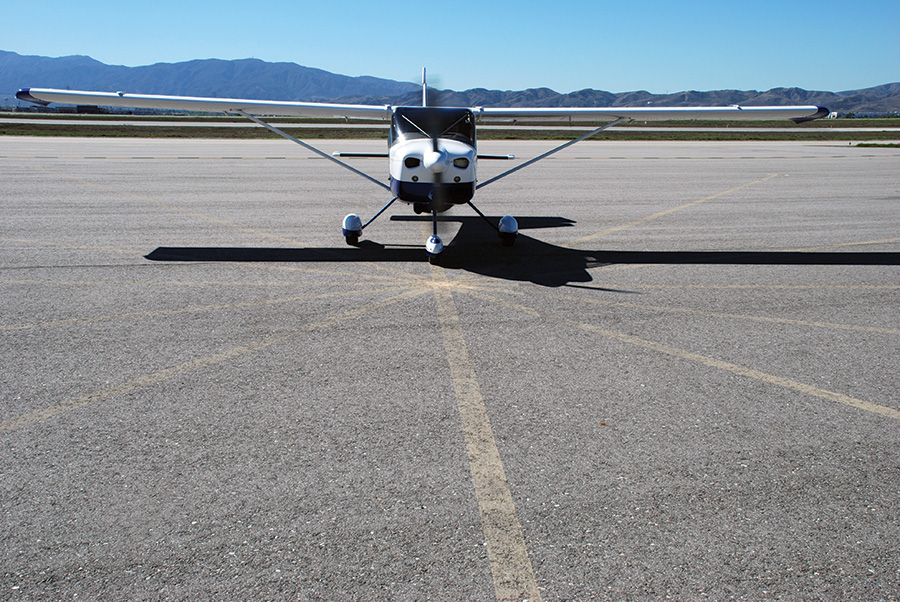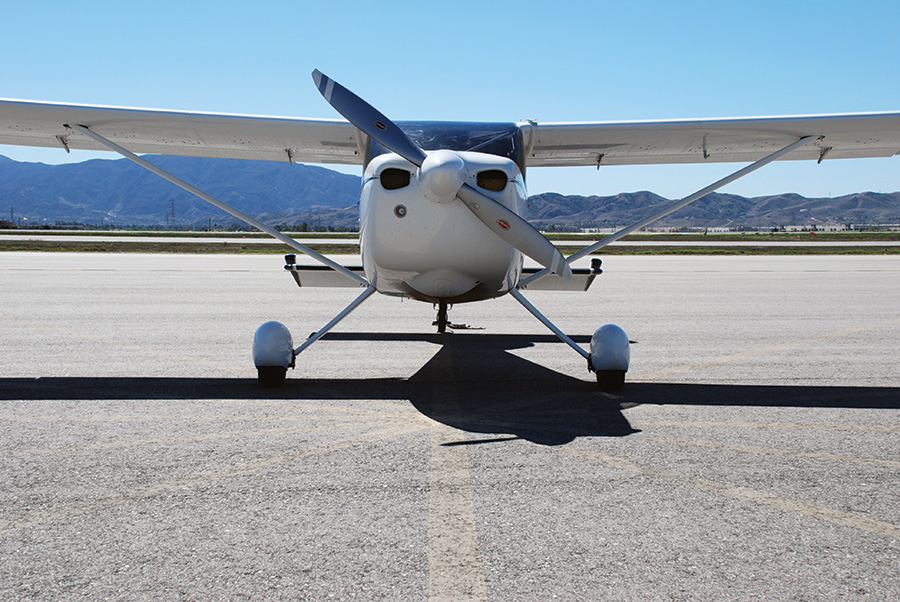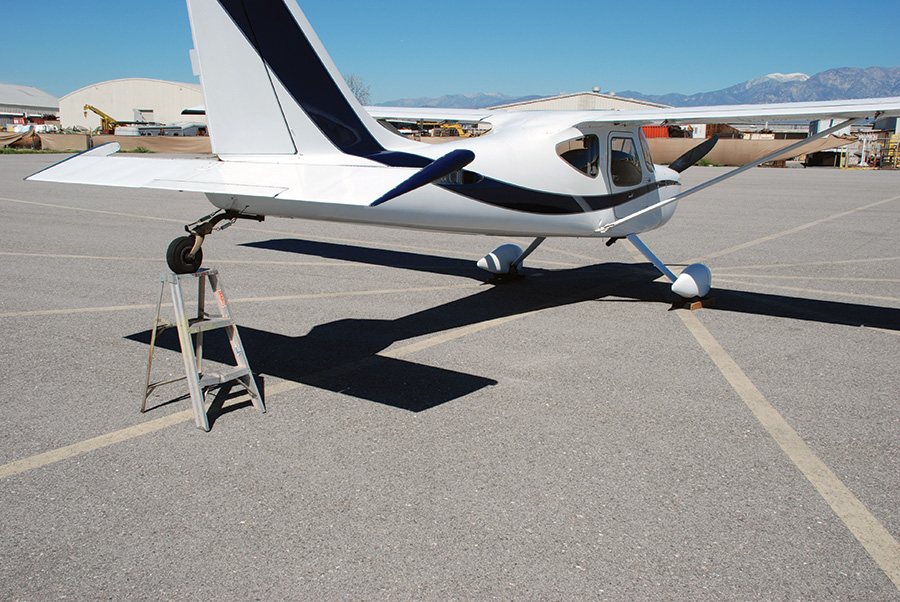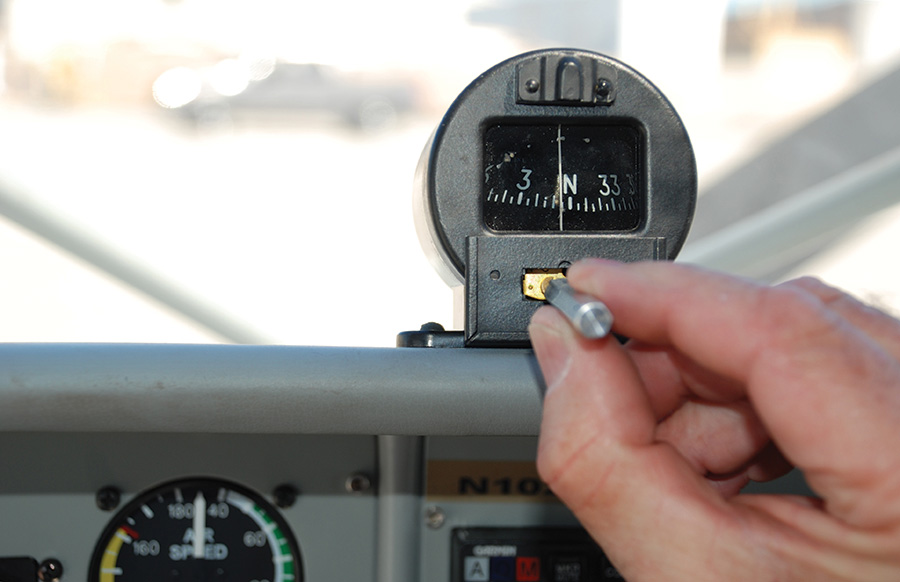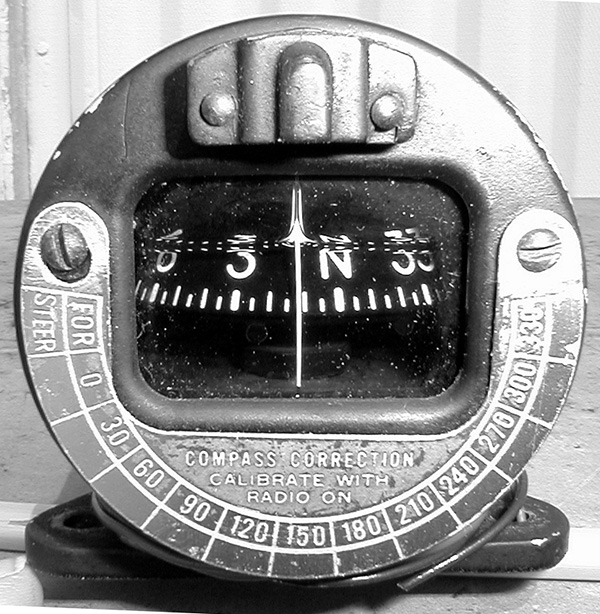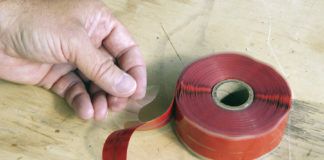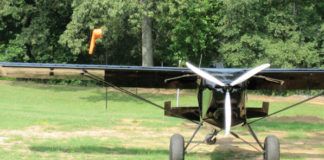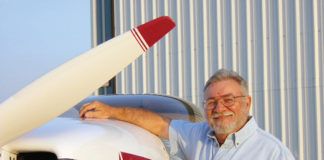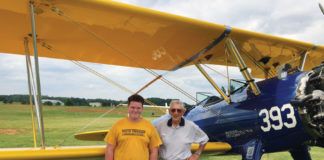Align your plane with the compass rose as closely as possible. You will need to keep your engine running if it affects your compass readings.
In this age of the ubiquitous GPS—handheld, panel-mounted, in your phone, even in your watch—the magnetic compass seems like an anachronism, a relic of a bygone era. But when the lights go out and nothing electrical works, the trusty magnetic compass will still tell you which way you are going. Although a compass is not required in an Experimental airplane for day-VFR flight, some sort of “magnetic direction indicator” is required, by way of standard operating limitations, for IFR and night operations, even in an Experimental aircraft. A primary flight display connected to a magnetometer can meet the requirement, but for the highest possible level of reliability, nothing beats the old magnetic compass. The question is, what do you need to do to make one work correctly in your airplane?
Before we even talk about swinging a compass, we need to think about its installation. The compass needs to be visible to the pilot, aligned with the longitudinal axis of the airplane, away from ferrous metals (iron and steel) as much as possible, and away from any potential sources of magnetism such as heavy wires and transformers. That said, there is usually no perfect place to put a compass in an airplane, unless you are flying an all-composite glider with no radios. For everyone else the location of the compass will be a compromise with the top of the glareshield being the most likely spot. Sometimes, in some planes, mounting the compass in the instrument panel may work, but usually not. Vertical card compasses seem to be especially difficult to sort out, but some people do get them to work. In any case, be sure to install your compass with brass screws, nuts, and lock washers.
In general keep magnets out of the cockpit to the extent possible and avoid placing things like headsets on the glareshield near the compass. Also be sure that all electrical items are well grounded to avoid magnetizing parts of your airplane such as steel cages and motor mounts.
Once we are satisfied with the installation of the compass the question arises, when do I need to swing my compass? In other words, when do I need to adjust it to be sure it is always pointing in the right direction at all headings? Certainly upon initial installation is one, but there are many other times when it is appropriate: after an especially hard landing or a bout with severe turbulence; after flying through an electrical storm, or heaven forbid, a lightning strike; after any addition or modification to the avionics or electrical system; after the plane has been sitting in one place for over one year without moving; or if you relocate your home base more than a few miles away. And lastly, if you repair, relocate, or replace your compass, it will need to be swung again.
This plastic tool came with the compass. Be sure to keep it in a safe place so you can find it later if you need to swing your compass again. Fill in the compass card when you are finished.
If you have a good compass rose on your field or nearby, it is fairly easy to do the actual swinging of the compass. If your airport does not have a compass rose and there isn’t one nearby, you can make your own. Look up the exact magnetic heading of the runway at your airport. You can find it online at www.airnav.com under information for your airport, or you can find it in the Airport and Facilities Directory. Find a taxiway parallel to the runway somewhere out of the way where you can lay out your rose. Be sure to consult with the airport manager before you do this. The yellow taxiway line should be at the same heading as the runway or at least close enough. You can then use a little trigonometry to lay out a north-south line and an east-west line. All you will need is a 50-foot tape, a piece of chalk or carpenter’s crayon, and a carpenter’s chalk box. If you are not at an airport where you have an exact magnetic heading reference, you can use any compass with the ability to sight in a line to do your layout. Today even many smartphones such as the iPhone have compass apps that you can use. However, it is good to verify their accuracy against a known reference line before using them to swing your aircraft compass. Your trusty Boy Scout compass will also do the job, but again, check it against a known reference.
With a compass rose now available, position the plane so it is heading exactly north. The plane should be level and the engine and avionics should be on. If you have a taildragger, you will need to jack up the tail to get it level. I know it is a royal pain, but you still have to do it. The plane doesn’t need to be perfectly level, but it should be close. Using the appropriate non-magnetic tool or screwdriver, adjust the compass until it reads exactly north. A new compass will often come with the needed tool, or you can buy one from your favorite aircraft parts vendor. Do not try to use a standard screwdriver for this process. After setting the compass to north, shut the engine off and see if the compass moves. Leave the radios on, because avionics can easily affect compass readings.
This short ladder lifts the tail enough to get the plane fairly close to level. Be sure to have plenty of help to lift the tail into position to avoid injury.
Next reposition the plane so it is facing exactly east. Start up the engine and the radios and set the compass to read exactly east. Then shut the engine off and see if the compass moves. If the compass did not move after turning the engine off in both positions, I would feel comfortable doing the rest of the swinging with the engine off. It is much easier and safer to jockey the plane into position with the engine off, but if it makes a difference you will need to have it running when you make each adjustment.
Now position the plane so it is facing due south. The compass will probably not read exactly south, so you will need to note how far off it is and correct for one-half the difference. In other words, if the compass reads exactly north when facing north and 176 degrees when facing south you, should adjust the compass until it reads 178 degrees when facing south. You are allowed an error of ten degrees, but hopefully you will be much closer. Note this heading for inclusion on your compass card when you are finished.
Now position the plane so it is facing west. Note the difference between 270 degrees and the heading indicated by the compass and again take out half the difference. If it made a difference to have the engine running before, be sure to start it up again before making your west adjustment. Again, note the corrected heading for your compass card. You will need to lift the tail to level the airplane each time if you have conventional gear. Obviously, this is not something you will want to try by yourself.
When you are finished with your west adjustment recheck north and east to verify the new adjusted headings. The corrections you made when facing south and west will have a similar effect on the north and east readings. Note the new heading corrections after you verify them.
After you have been all the way around the compass once, plus rechecking east, you should have four corrected headings that are pretty close, but not exactly on the cardinal headings of 0, 90, 180, and 270. For instance your compass may point to 2, 91, 178, and 272 degrees. If so that’s fine. Just note these headings on your compass card and remember to steer north you will need to fly at a heading of two degrees on your compass.
This iPhone has a compass app that you can use in a pinch, but as you can see from the display, it is a few degrees off.
Once your cardinal heading corrections are established, you can go around the compass one more time at 30 degree increments and note the corrected headings. As always, the plane should be level, and the engine should be running if it previously made a difference. Generally you should not try to correct these intermediate headings because you will just throw off the cardinal heading adjustments. Just note them for the compass card. When you are all done, fill out your compass card, date it, and place it in view next to the compass.
If you just can’t get your compass to come into adjustment, you may have some magnetized steel somewhere in the plane. A good way to check for magnetized metal is to make a sensor out of two paper clips. Lace them together so one can hang from the other. Then pass the hanging paper clip near any suspected metal and see if it swings towards that metal. If you find a magnetic source, see if it can somehow be removed. If it is a permanent part of the airplane, the engine mount for example, you will need to degauss (demagnetize) it. It may take some searching to find someone near you with the proper equipment. Common sources of magnetized airframe parts include poorly grounded starters and alternators, and improper grounding during electric welding. If possible try to identify and eliminate the source of magnetizing so it doesn’t recur.
The owner of this plane uses a non-magnetic aluminum screwdriver to adjust his compass. There are two adjustment screws: one for north-south and one for east-west.
Compass compensators, small magnets located near the compass, may help with a compass that refuses to come into allowable limits. These are available form Aircraft Spruce and other aviation vendors. Metal shielding between the radios and the compass may also help in some cases. If you have a badly magnetized cage in a plane such as a Cub, you may have no choice except to have the cage degaussed. Unfortunately, you may have to travel some distance to connect with someone who has the proper equipment and skill to perform this task.
Fluid has leaked or evaporated from this compass. To make it airworthy it needs to be refilled so there is no air left inside. It may also need to have a leak repaired.
If your compass has an air bubble visible inside it, you need to top off the fluid. This should only be done with compass fluid that meets MIL-C-5020A specifications. It is inexpensive and readily available, so there is no excuse for using non-approved fluid. Compass repair kits are also available for the more common compasses, in case yours is leaking. Repairs beyond those possible with the basic repair kit should be left to an instrument repair shop, or simply replace the compass.
If the movement of your compass seems erratic, it may have internal damage. To check that it will swing freely, move a magnetic source, such as a headset, close to it, then then pull it away quickly. The compass should freely swing towards the magnet and then return to the exact same place it was before the magnet came near. If it does not, you need to repair or replace your compass.
With any luck at all you will get many years of service out of your magnetic compass and will have to do almost nothing in the way of maintenance. With a panel full of modern avionics, you may never even look at your compass. But if you ever lose all your fancy equipment and still need to find your way home, your trusty magnetic compass will be there to point the way.
Photos: Dave Prizio and Light Planes Maintenance

